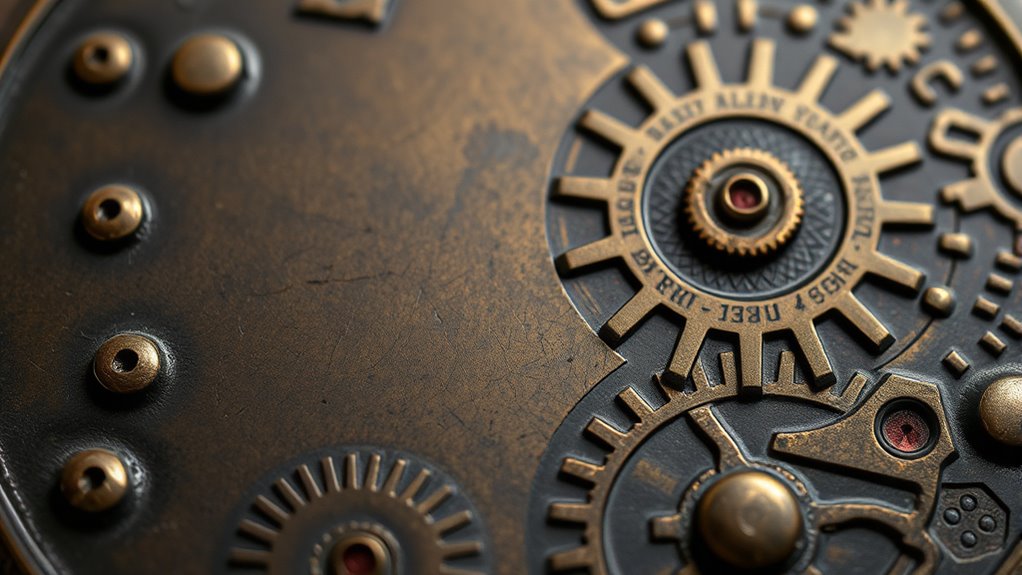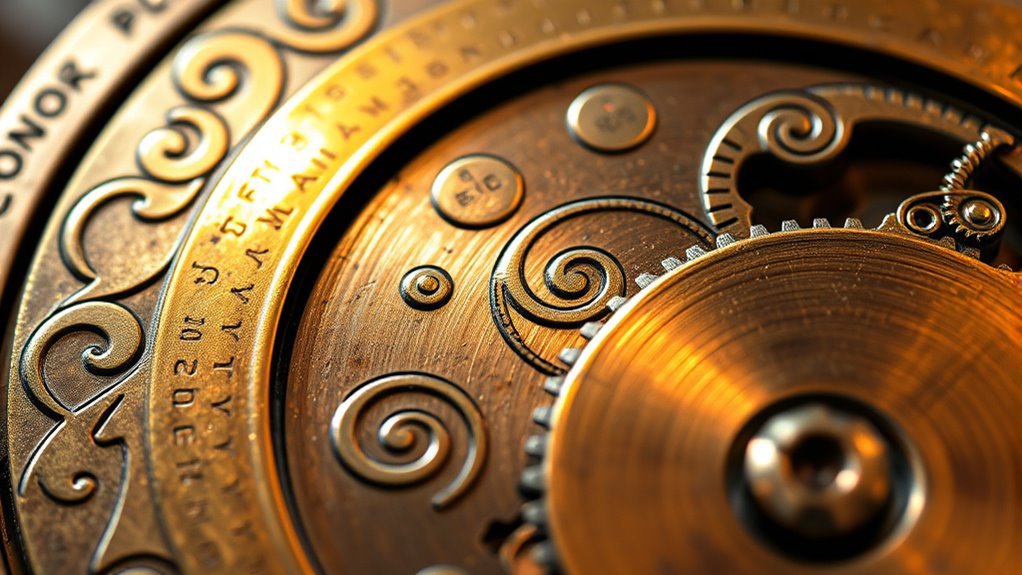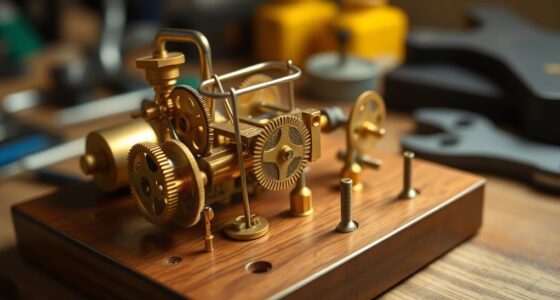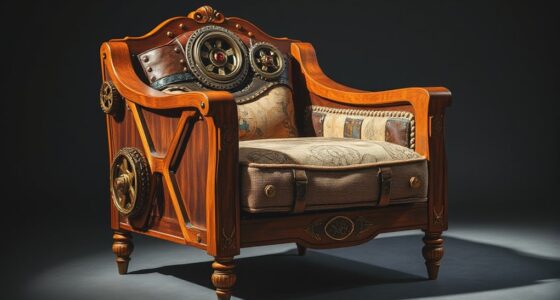To achieve steampunk detailing on metal, you can use both etching and engraving techniques. Engraving involves carving fine lines and intricate patterns directly into the metal surface with sharp tools, offering tactile depth and precision. Etching, on the other hand, uses acids or chemicals to create detailed, delicate designs by controlling where the material gets removed. Combining these methods allows you to craft layered, durable designs that truly capture the steampunk aesthetic—exploring these techniques will uncover even more possibilities.
Key Takeaways
- Engraving involves carving fine lines into metal for detailed, tactile steampunk motifs, offering handcrafted control and depth.
- Etching uses chemical reactions with resist masks to create intricate, highly detailed designs suitable for complex steampunk patterns.
- Combining etching and engraving techniques allows layered, precise, and elaborate steampunk decorative effects on metal surfaces.
- Both methods require steady hands, careful planning, and skill to produce durable, visually striking steampunk-inspired metal art.
- These techniques enhance jewelry and decorative pieces by adding lasting, detailed steampunk detailing with customizable textures.

Etching and engraving metal are two popular techniques used to create detailed and lasting designs on metal surfaces. When you work with these methods, you’re able to transform a plain piece of metal into a stunning work of art that captures the intricate details of steampunk aesthetics. The key to achieving impressive results lies in understanding how each technique interacts with the metal surface and how to maximize design precision. Whether you’re customizing jewelry, creating decorative panels, or crafting unique accessories, mastering these techniques elevates your craftsmanship.
Engraving involves removing material from the metal surface using sharp tools like burins or gravers. This process allows you to carve fine lines and precise patterns directly into the metal, giving you complete control over the design. When working on a metal surface, you need a steady hand and a clear plan to ensure the lines are crisp and consistent. The depth of your engraving can vary, adding texture and contrast that enhances the steampunk look. Because engraving is a subtractive process, every stroke matters—careful planning ensures your design maintains its clarity and detail. You can use different tools for different effects, from fine-pointed gravers for delicate lines to broader tools for bolder shading.
Etching, on the other hand, uses acid or other chemicals to eat away at the metal surface, creating recessed designs. This technique is excellent for producing complex, repeating patterns or detailed images that would be difficult to carve by hand. To achieve high design precision in etching, you first need to carefully apply a resist or mask to the metal, protecting areas you want to remain untouched. When the metal is exposed to etchant, the chemical reaction creates precise lines and textures. The process allows for very fine detail, especially when combined with techniques like aquatint or drypoint. Etching also offers the advantage of reproducing intricate designs consistently, which is perfect for steampunk motifs featuring gears, machinery, and Victorian embellishments. Additionally, understanding copper etching techniques can help in achieving more refined and detailed results.
Both techniques demand patience and attention to detail, but they offer different advantages. Engraving provides tactile depth and a handcrafted feel, perfect for personalized touches. Etching, meanwhile, excels at capturing intricate, delicate details with a high level of accuracy. As a steampunk enthusiast, you can combine both methods—engraving for bold outlines and etching for detailed shading—to produce layered, complex designs that embody the genre’s elaborate aesthetic. With practice, you’ll develop a steady hand and an eye for precision, allowing you to craft stunning, enduring pieces that celebrate the intricate beauty of steampunk design on every metal surface.
Frequently Asked Questions
What Safety Precautions Are Necessary During Metal Etching?
When working with metal etching, you need to prioritize safety. Always wear protective gear like gloves, goggles, and a respirator to shield yourself from harmful fumes and chemicals. Handle chemicals carefully, following all safety instructions and labeling. Work in a well-ventilated area to avoid inhaling fumes. Never bypass safety measures; these precautions protect you from skin irritation, chemical burns, and respiratory issues, ensuring a safe and successful etching process.
Can These Techniques Be Used on All Types of Metals?
Think of metal compatibility as a lock and surface preparation as the key—you need both to unlock your creative potential. Not all metals respond equally to etching and engraving; some require special surface prep to achieve the best results. Before you start, research your metal’s properties. This way, you ensure your techniques work smoothly, giving your steampunk designs that perfect, intricate detail you’re aiming for.
How Long Does a Typical Engraving Process Take?
The duration estimate for an engraving process varies depending on factors like design complexity, metal type, and tool precision. Usually, it takes anywhere from a few minutes for simple designs to several hours for intricate details. You should consider these factors influencing time when planning your project, as more detailed engravings naturally demand longer durations to guarantee quality. Ultimately, your specific design and materials will determine how long the process lasts.
Are There Eco-Friendly Alternatives to Chemical Etching?
You might think chemical etching isn’t eco-friendly, but biodegradable acids offer a natural alternative. These acids break down safely, reducing environmental impact. Natural etching methods, like using citrus or vinegar-based solutions, are effective for detailed work while being gentle on the planet. By choosing biodegradable acids and natural solutions, you can achieve stunning steampunk detailing without harming the environment, proving sustainable options can be both beautiful and practical.
What Tools Are Essential for Beginners in Steampunk Metal Detailing?
To get started with steampunk metal detailing, you’ll want essential tools like metal stamping sets for adding intricate designs and textures. A good patina application kit helps you create authentic aged effects, giving your pieces that vintage look. You should also have basic hand tools like hammers, files, and pliers. These tools are user-friendly for beginners and will help you craft detailed, professional-looking steampunk accessories with ease.
Conclusion
Now that you’ve learned the ins and outs of etching and engraving, you’re ready to add those intricate steampunk details to your metalwork. Remember, Rome wasn’t built in a day; patience and practice are key. With each scratch and etch, you’ll refine your skills and bring your unique vision to life. Keep at it, and soon you’ll turn plain metal into a mesmerizing piece that truly stands out—showing that persistence pays off in the end.









